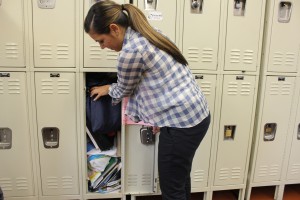Two eighth grade students sat at a table in their school’s hallway, trying to concentrate on their speech therapist’s iPad screen. Elevator doors opened in front of them. Students walked in and out of restrooms less than five feet away. This was the regular “classroom” for therapy at Harlem’s Opportunity Charter on West 113th Street, where more than half its 420 middle and high school students have special needs.
It’s distracting, because you hear a lot of people talking,” said 13-year-old Senay Mejia, “and I’m trying to work back here.”

Making matters even more frustrating, one floor below are two empty, locked classrooms – one for dance, another for speech therapy. Those rooms belong to Harlem Success Academy 4, another charter school in the building with some 300 kindergartners through fourth graders.
In the recent past, most of the contentious battles over school space in the city have erupted when a charter school has tried to share the same floor with a traditional public school. In this case, the space crunch is between two charter schools, both of which are very different models. “It’s charter versus charter here,” said Vice Principal Shantè Spivey about the space battles.
The space crunch is not about to end. In April, Mayor Michael Bloomberg announced his plans to close 24 more public schools and open 54 new ones—24 of them charters. In Opportunity’s case, the education department had threatened to close it last December because of its rocky test scores, but at the last minute gave it a two-year reprieve.
There is also a third public elementary school in the former Public School 241 building – Manhattan STEM Institute, specializing in science, technology, engineering and math. Of all three schools, Opportunity is the largest, and has arguably the greatest challenges. Its struggle for space may be compromising its difficult mission to teach classes mixed almost equally with special education and regular education students.
Most days, friends of Mejia and her classmate, Philip Young, stop by the makeshift therapy spot to greet them on their way to the restroom. On bad days, classmates see them sitting with speech therapist Jackie LaMorte and tease them later for being in special education. “I don’t feel embarrassed because they call me stupid. If you ask me, do I care?” said Mejia, pausing to preach in front of her small audience. “I do not, because I’m smarter than them.”
LaMorte has learned to adjust to limited space since she began teaching at Opportunity last September. “I mean it’s distracting but what can I do?” she said. “Wherever I can work, I work.”
Even though its special education needs are so intense, Opportunity no longer has room for a permanent classroom for students who need self-contained therapy sessions outside of their classroom.
This has left many teachers and support staff frustrated by the lack of options. One teacher has left and others are considering leaving because they say they cannot do their work or handle the stressful environment.
“I do love working here. I really like the mission of the school – that it is an inclusion model,” said Julia Facey, a special education teacher who teaches ninth grade English. The inclusion model places special needs students in the class with their peers who don’t require additional support. The idea is to help special needs students socialize instead of isolating them in contained classrooms.
But the stress is becoming overwhelming for Facey. “What I’m worried about is that I’ll make the decision not to be here because of the challenges that the space provides,” she said.
Like LaMorte, Facey is in her first year at Opportunity. She previously worked for the Department of Education’s District 75, for special education. “When I came for the interview, they did talk about the space issue,” Facey said. “But until you are actually faced with it, you have no idea.”
Founded in 2004, the charter school was originally at a different Harlem location. The Department of Education moved Opportunity Charter to P.S. 241 in 2006. At the time, STEM, which was then known as Family Academy, was the only occupant in the building. Opportunity received the top two floors of the four-story building. In 2008, former City Council member Eva Moskowitz moved her fourth charter school in her well-known charter network, Harlem Success Academy, into the building.
Today, the three schools share the auditorium, gymnasium, and schoolyard. Everything else is, to some extent, annually up for negotiation with the Department of Education, which owns the building.
According to Anthony Rivera, Opportunity’s operations manager, the city’s rules are based on a Footprints metric that determines the school’s need for space by reviewing the number of students who receive special education and general education with the square footage of its allocated classrooms.
In recent years, Opportunity lost three classrooms because of the Footprints’ calculations, which the Department of Education explained was a temporary decision. The three classrooms were supposed to be given back the next year.
The Department of Education gave those three classrooms to STEM, which then lost them to Success Academy the following year, said Rivera. “This year, even though STEM has one of the rooms, they were nice enough to donate it to the entire community as a staff lounge,” he added.
The other two rooms, 318 and 321, now belong to Success Academy. Room 321 was converted from a classroom into a dance studio and Room 318 is for speech therapy.
Facey peered into the empty dance therapy room from a small window on the door. “A lot of our students are being serviced in the hallway, but there’s a dance studio,” she said. “The speech room is hardly ever used.” Both are locked when Success Academy doesn’t use them.

Opportunity’s space constraints affect everyone, not just those in special education. Two years ago, three full-sized classes were split in half, with permanent walls and new doorways created so more classes could use the space. Now all the classrooms have multiples uses. The third floor copy machine room is used for tutoring and therapy. The school also allocates rooms for the Children’s Aid Society, which offers students social services through the Carrera program, which works to prevent teen pregnancy.
“We’re making the most out of the least,” said Rivera.
Sometimes, however, even doubling up rooms is not an adequate solution. Earlier in April, high school students were asked to stay at home for half the day to make room for the middle school students who were taking the state’s Regent exams. State regulations require some students with special needs to take the test in a separate room.
“You may have just five students who have a certain accommodation but now you have to find a location,” said Rivera, who is also known as “The Negotiator,” because he represents the school in meetings about the building’s space. “We needed both floors to do this.”
None of these problems are new to Leonard Goldberg, Opportunity’s CEO. “We’re in constant contact with the Department of Education about the space situation here,” said Goldberg.
Opportunity Charter has a troubled past. In 2010, the city’s Special Commissioner of Investigation looked into an anonymous accusation that school officials were physically restraining students. Although Goldberg said the accusations were false, several staff members were fired. In 2011, teachers won a well-publicized fight to unionize, but not before 15 teachers were fired at the end of the school year.
The city’s threat to close Opportunity poses another problem. “It makes it difficult for us to make long-term plans when we have short-term renewals,” said Goldberg.
Student scores have suffered as well. Of the non-special education students tested for the English Regents exam in 2010-2011, only 2 percent scored 85 percent or above. Only 20 percent of students passed the math exam. Students fared better in writing, with 80 percent passing.
The statistics are difficult to ignore, but the circumstances may be unique: Opportunity accepts a significant rate of students who have low academic records and special needs.
Most people believe that charter schools cream the top students, but the opposite is the case at Opportunity. “They don’t look at our population and say, wow, you guys are doing some special work here,” said Rivera, who has taught at the school since it opened. “Let’s try to find you some space to get you the room that you need in order to operate.”
As Opportunity constricted, Harlem Success expanded. The newest charter school occupies three classrooms in the basement, six classrooms on the first floor, the two classrooms that originally belonged to Opportunity on the third floor, and the annex, which is the newer part of the building.
The high-profile Success Academy network attracts a great deal of attention, much of it negative, from local parents and activists who are concerned that it is growing too fast.
“Opportunity Charter School is one of the very few charter schools that’s actually educating all kids,” said Noah Gotbaum, chair of the Community Education Council in School District 3. “The system is completely rigged against special needs kids, and those who are most difficult to educate.”
The Department of Education’s press secretary, Matthew Mittenthal, said he couldn’t respond to past space decisions. He added that department officials are always working to resolving conflicts over building use.
The Footprint plan is “a guide for the allocation of space in the building, but it’s not a rule,” said Mittenthal. “It is used by the building council as a starting point to determine how to share space fairly.”
For now, Opportunity doesn’t expect the school to lose more space to Success Academy. In mid-May, the Chancellor’s office recommended that the school’s contract be renewed for another five years.
“The five-year renewal makes a big difference in everyone’s mind. It definitely validates what we do,” said Rivera, Opportunity’s operations manager.
Even so, the school’s current cramped environment has proved to be too stressful for at least one speech therapist, who left after only two months because she felt she could not do her job.
“Opportunity was the only place I’ve worked where the space situation was so dire,” said Susan Salinger, who quit in December and now splits her time between a public elementary and a Crown Heights charter school. “I knew I could do a lot more. Those kids needed it so much. It was a really difficult to leave.”
The lack of space may have stressed her out, but it affected the students even more.
“It conveys something to the kids,” she said. “That they’re not worth it.”



Can I make a suggestion? I think youve got something good here. But what if you added a couple links to a page that backs up what youre saying? Or maybe you could give us something to look at, something that would connect what youre saying to something tangible? Just a suggestion.